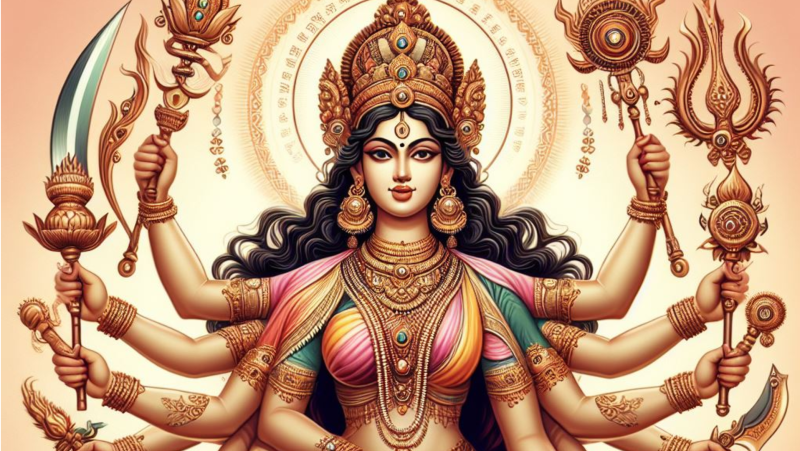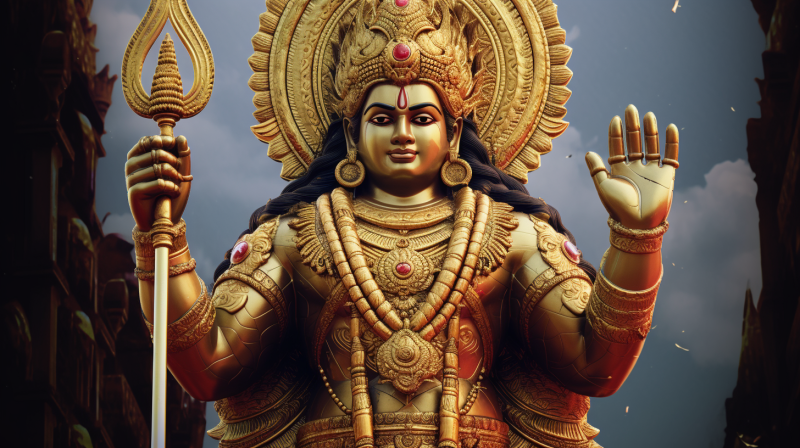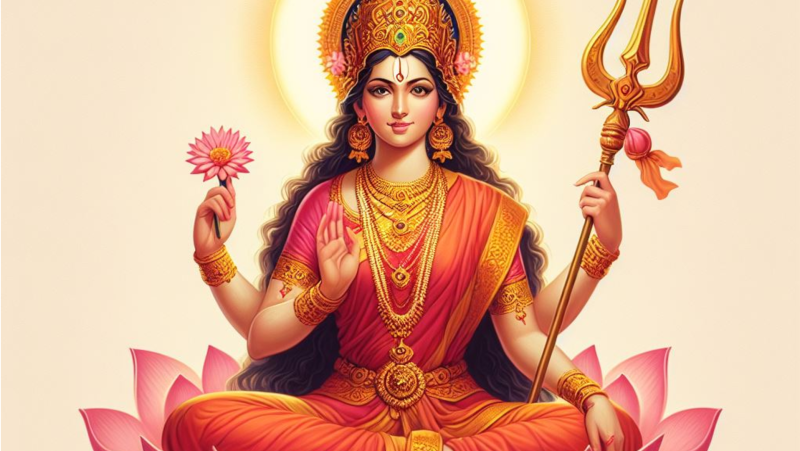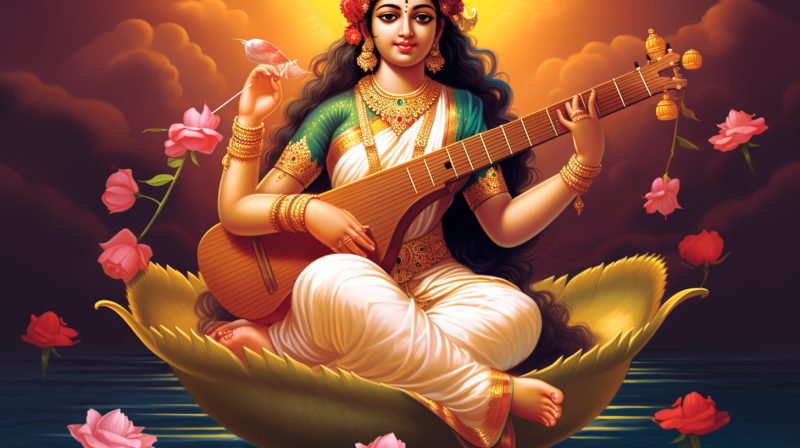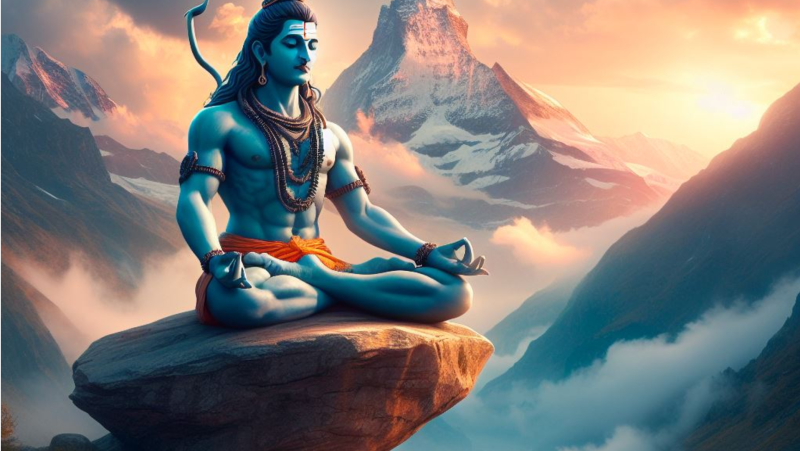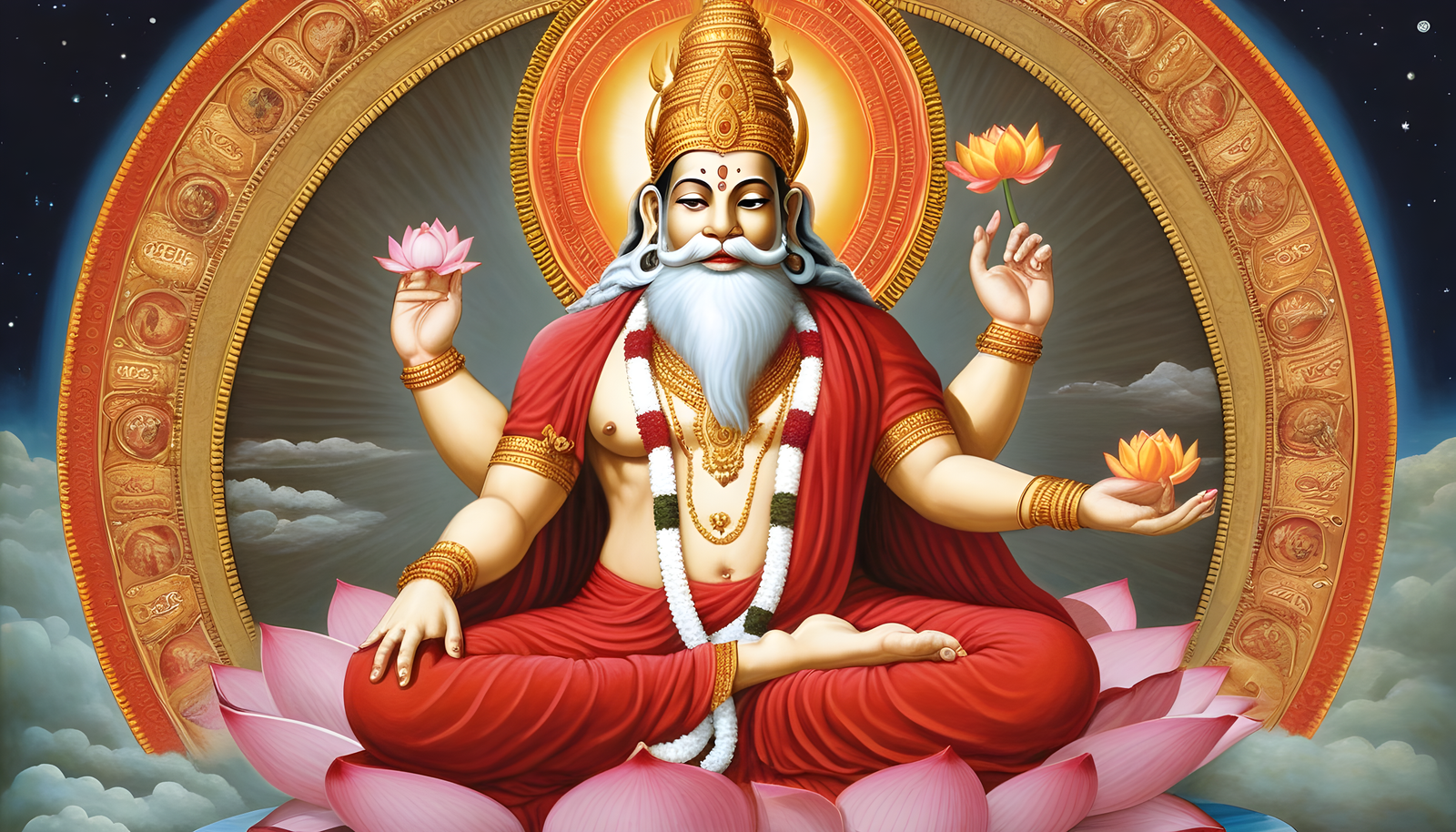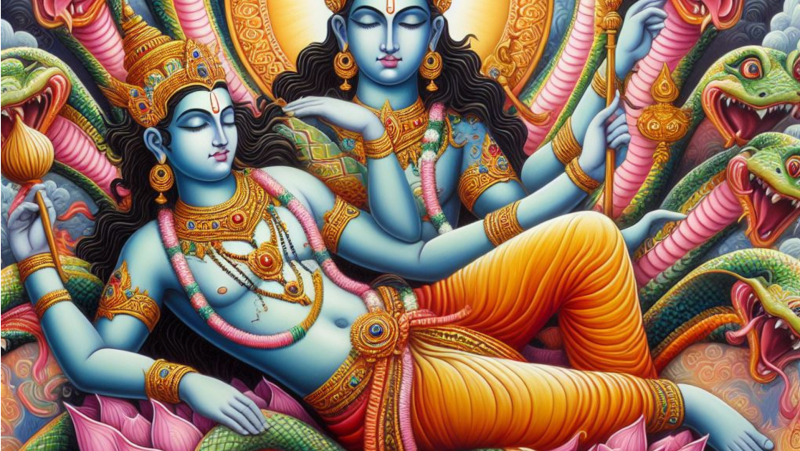
In Hinduism, Lord Vishnu also know as Bhagwan Vishnu is one of the principal deities and a part of the Hindu trinity known as the Trimurti, alongside Brahma (the creator) and Shiva (the destroyer). Here are key aspects and details about Lord Vishnu:
About Lord Vishnu - The Preserver of the Universe
In Hinduism, Bhagwan Vishnu plays a significant role in the cosmic order as the Preserver and Sustainer of the universe. His role involves several aspects that contribute to maintaining balance and harmony in existence:
1. Preservation of the Universe:
• Vishnu's primary role is to preserve and maintain the universe. He sustains cosmic order by ensuring the continuity of life and creation.
2. Upholding Dharma (Righteousness):
• Bhagwan Vishnu stands as a guardian of dharma, ensuring that moral and cosmic laws are upheld. He intervenes whenever there is a threat to righteousness and order in the universe.
3. Incarnations (Avatars):
• Vishnu incarnates in various forms or avatars to restore balance and righteousness. His avatars include Rama, Krishna, Buddha, and others, each descending to earth to fulfill a specific cosmic purpose.
4. Balancing Creation and Destruction:
• He oversees the cycle of creation, preservation, and dissolution. While Brahma creates the universe and Shiva is responsible for its dissolution, Vishnu ensures its continuity and preservation between these cycles.
5. Guidance and Protection:
• Devotees seek Bhagwan Vishnu's guidance and protection. He is believed to respond to prayers and offer solace and protection to those who seek his blessings.
6. Relationship with Goddess Lakshmi:
• Vishnu is often depicted with Goddess Lakshmi, signifying prosperity and wealth. Their union symbolizes the harmony between material abundance and spiritual well-being.
7. Bhagavad Gita - Dispensing Wisdom:
• Vishnu imparts spiritual wisdom in the Bhagavad Gita to Arjuna, teaching about righteousness, duty (dharma), and the path to spiritual enlightenment.
8. Ensuring Cosmic Harmony:
• Bhagwan Vishnu maintains balance and cosmic harmony, ensuring that the universe functions in an orderly manner.
9. Providing Divine Intervention:
• Vishnu intervenes in various mythological stories to restore balance, vanquishing evil forces and protecting devotees from harm.
10. Symbolism of Universal Compassion:
• His benevolent and compassionate nature reflects a universal concern for the welfare of all beings, emphasizing virtues such as love, compassion, and righteousness.
In essence, Vishnu's role encompasses preserving the cosmic order, maintaining righteousness, ensuring the continuity of the universe, and guiding souls towards spiritual fulfillment and liberation.
About Lord Vishnu Iconography and Attributes
Lord Vishnu is depicted in various forms, each with specific iconographic attributes that symbolize his divine characteristics and cosmic roles. Here are details about Lord Vishnu's iconography and attributes:
1. Complexion and Attire:
• Bhagwan Vishnu is often depicted with a bluish complexion (Shyam Sundar), symbolizing infinity, tranquility, and the color of the infinite sky.
• He wears vibrant garments, usually golden yellow or saffron, adorned with jewels that reflect his divine stature.
2. Four Arms:
• Vishnu is commonly depicted with four arms, each holding significant symbolic attributes representing his cosmic roles and powers.
3. Divine Attributes in Each Hand:
• Conch (Shankha): Symbolizes the sound of creation, purity, and the call to awaken spiritual seekers.
• Discus (Sudarshana Chakra): Represents the wheel of time, cosmic order, and the power to destroy evil forces.
• Mace (Gada): Symbolizes strength, control, and the eradication of ignorance and evil.
• Lotus (Padma): Symbolizes purity, enlightenment, and liberation. The lotus in Vishnu's hand represents divine grace and detachment from the material world.
4. Crown and Adornments:
• Bhagwan Vishnu wears a majestic crown (Kiritamukuta) adorned with jewels, signifying his royal status and divine authority.
• He is embellished with various ornaments like necklaces, bracelets, and earrings that symbolize his opulence and divine presence.
5. Serpent Adornment:
• Vishnu is often depicted resting on the coiled serpent Shesha or Ananta, symbolizing timelessness, eternity, and the unmanifested cosmic energy.
6. Vehicle - Garuda:
• Vishnu's divine vehicle (Vahana) is Garuda, the mythical eagle. Garuda represents speed, power, and protection, serving as Vishnu's mount.
7. Ananta Shesha:
• Ananta Shesha, the cosmic serpent, also symbolizes eternity and serves as Vishnu's resting place in his cosmic form as Narayana (lying on the cosmic ocean).
8. Posture and Depiction:
• Vishnu is often depicted in a standing or sitting posture, signifying his eternal presence and cosmic stability.
• He is sometimes portrayed reclining on the serpent Shesha, signifying his role in preserving the universe during its cycles of creation and dissolution.
9. Universal Symbolism:
• Vishnu's iconography reflects attributes of cosmic order, protection, maintenance, and the sustenance of life in the universe.
10. Forms and Avatars:
• Vishnu's iconography may vary based on his different forms and avatars, each representing specific cosmic purposes and roles in maintaining cosmic order.
These iconographic attributes of Lord Vishnu symbolize his divine nature, cosmic roles, and cosmic significance in Hindu mythology and spirituality.
About Lord Vishnu Avatars (Incarnations)
Lord Vishnu, is believed to incarnate in various forms, known as avatars, to restore cosmic balance, protect dharma (righteousness), and guide humanity. Here are the primary avatars (incarnations) of Lord Vishnu:
1. Matsya Avatar (The Fish):
• Bhagwan Vishnu appeared as a fish to rescue the Vedas and the sages during a great deluge (Pralaya), guiding the sage Manu's boat to safety.
2. Kurma Avatar (The Tortoise):
• Kurma avatar emerged as a tortoise to support Mount Mandara during the churning of the ocean (Samudra Manthan) to obtain the nectar of immortality (Amrita).
3. Varaha Avatar (The Boar):
• Bhagwan Vishnu incarnated as a divine boar to rescue the Earth (Bhudevi) from the demon Hiranyaksha, lifting her from the cosmic waters using his tusks.
4. Narasimha Avatar (The Man-Lion):
• Narasimha avatar appeared as a half-man, half-lion to protect his devotee Prahlada and defeat the demon king Hiranyakashipu, restoring dharma.
5. Vamana Avatar (The Dwarf):
• Vamana avatar manifested as a dwarf Brahmin to subdue the demon king Bali by seeking three steps of land. Vamana expanded to encompass the entire universe in three strides.
6. Parashurama Avatar:
• Parashurama avatar, a sage wielding an axe, appeared to rid the world of corrupt and oppressive Kshatriya rulers, restoring balance and dharma.
7. Rama Avatar:
• Rama avatar, the prince of Ayodhya, exemplifies righteousness and ideal kingship. He defeated the demon king Ravana, restoring order and fulfilling his duties.
8. Krishna Avatar:
• Krishna avatar, a divine cowherd and prince of the Yadava dynasty, played a pivotal role in the Mahabharata, imparting the Bhagavad Gita and guiding Arjuna in upholding dharma.
9. Buddha Avatar (Buddha Kalki - Future Incarnation):
• Some traditions consider Buddha as an avatar of Vishnu, appearing to restore balance and reform sacrificial practices.
10. Kalki Avatar (Future Incarnation):
• Kalki avatar is prophesied to appear in the future, riding a white horse, to end the present age of darkness (Kali Yuga), restore righteousness, and bring about a new cosmic cycle.
These avatars of Lord Vishnu serve specific cosmic purposes, aiming to restore balance, uphold righteousness, and guide humanity towards spiritual enlightenment and righteousness. Each avatar represents a unique aspect of divine intervention and cosmic order in Hindu mythology.
About Lord Vishnu Relationship with Goddess Lakshmi
In Hindu mythology, Bhagwan Vishnu, shares a divine and inseparable relationship with Goddess Lakshmi, the goddess of wealth, fortune, prosperity, and beauty. Here are the details about Lord Vishnu's relationship with Goddess Lakshmi:
1. Consort of Lord Vishnu:
• Goddess Lakshmi is the divine consort (shakti) of Lord Vishnu. Their union symbolizes harmony, prosperity, and spiritual wealth.
2. Symbolic Representation:
• Lakshmi is often depicted as sitting or standing alongside Lord Vishnu in various iconographic representations, symbolizing their eternal partnership and cosmic unity.
3. Symbolism of Wealth and Prosperity:
• Lakshmi represents material and spiritual prosperity. Her association with Vishnu signifies the importance of wealth and abundance in maintaining cosmic balance and well-being.
4. Lakshmi-Narayana Aspect:
• Together, they form the divine couple known as Lakshmi-Narayana, where Lakshmi embodies the energy and grace that supports and enriches the universe while Vishnu maintains and preserves it.
5. Spiritual Harmony:
• Their relationship signifies the balance between material wealth (Lakshmi) and spiritual well-being (Vishnu). It teaches the devotees the importance of balancing material prosperity with righteousness and spiritual fulfillment.
6. Mutual Support and Interdependence:
• Vishnu is believed to derive strength and support from Lakshmi's presence, just as Lakshmi's existence is intertwined with Vishnu's cosmic role as the Preserver.
7. Symbolic Representations in Temples:
• In many temples dedicated to Lord Vishnu, Lakshmi resides alongside him or near his sanctum, symbolizing their spiritual and cosmic union.
8. Importance in Festivals and Worship:
• Devotees often worship both Lord Vishnu and Goddess Lakshmi together, especially during festivals like Diwali and Vaikuntha Ekadashi, seeking their blessings for wealth, prosperity, and spiritual growth.
9. Universal Harmony and Cosmic Balance:
• Their divine partnership signifies the union of feminine and masculine energies, promoting universal harmony, prosperity, and cosmic balance.
10. Mutual Love and Devotion:
• The relationship between Vishnu and Lakshmi represents divine love, devotion, mutual respect, and eternal companionship.
The relationship between Lord Vishnu and Goddess Lakshmi symbolizes the harmony between material and spiritual realms, emphasizing the importance of wealth, prosperity, and spiritual fulfillment in maintaining cosmic balance and well-being.
About Lord Vishnu as Protector and Guardian
Lord Vishnu, revered as the Preserver in Hinduism, embodies the qualities of protection, guardianship, and preservation in the cosmic order. Here are comprehensive details about Lord Vishnu as a Protector and Guardian:
1. Sustainer and Preserver:
• Vishnu's primary role is to sustain and preserve the universe. He maintains cosmic order, ensuring the continuity of life and creation.
2. Upholder of Dharma (Righteousness):
• Bhagwan Vishnu acts as the guardian of dharma, ensuring moral and cosmic laws are upheld. He intervenes whenever there is a threat to righteousness and order in the universe.
3. Divine Intervention:
• Vishnu takes various avatars (incarnations) to protect devotees, restore cosmic balance, and vanquish malevolent forces threatening the universe.
4. Avatars as Protectors:
• Through avatars like Rama and Krishna, Vishnu displays valor, protects devotees, and defeats evil entities, ensuring the triumph of good over evil.
5. Protector of Devotees:
• Devotees invoke Vishnu's protection and seek refuge in times of distress, believing in his divine intervention and guidance.
6. Preserving Moral Order:
• Vishnu's guardianship extends to preserving moral order and cosmic balance, ensuring justice and protecting the virtuous.
7. Symbolism of Protection:
• His divine attributes, such as the discus (Sudarshana Chakra) and the conch (Shankha), symbolize his protective nature and power to shield devotees from adversities.
8. Relationship with Devotees:
• Bhagwan Vishnu is regarded as compassionate and benevolent towards his devotees, offering them protection, solace, and guidance.
9. Upholding Cosmic Harmony:
• Vishnu's vigilant guardianship ensures the harmony and continuity of the universe, maintaining equilibrium and protecting it from potential disruptions.
10. Role in Cosmic Cycles:
• Vishnu plays a crucial role in preserving the universe during its cycles of creation, preservation, and dissolution, safeguarding it from chaos and ensuring its sustenance.
In essence, Lord Vishnu serves as a protector and guardian in Hindu mythology, intervening to maintain cosmic order, protect dharma, and safeguard the well-being of devotees, symbolizing the eternal principle of protection and preservation in the cosmic cycle.
About Lord Vishnu | Appearance & Symbols
Lord Vishnu, is depicted with specific appearance and symbols that signify his divine attributes and cosmic role. Here are comprehensive details about Lord Vishnu's appearance and symbols:
1. Appearance:
• Physical Attributes: Vishnu is often portrayed with a bluish complexion (Shyam Sundar), symbolizing infinity, tranquility, and the vastness of the sky.
• Attire: He wears royal garments, typically golden yellow or saffron, adorned with jewels, reflecting his divine status and opulence.
• Multiple Limbs: Vishnu is commonly depicted with four arms, a distinctive feature symbolizing his omnipotence and cosmic presence.
2. Iconographic Attributes:
• Four Arms: Each arm holds significant symbolic attributes representing his cosmic powers and roles.
- Conch (Shankha): Symbolizes the divine sound of creation, purity, and the call to awaken spiritual seekers.
- Discus (Sudarshana Chakra): Represents the wheel of time, cosmic order, and the power to destroy evil forces.
- Mace (Gada): Symbolizes strength, control, and the eradication of ignorance and evil.
- Lotus (Padma): Symbolizes purity, enlightenment, and liberation, representing divine grace and detachment from the material world.
3. Divine Crown and Adornments:
• Bhagwan Vishnu wears a majestic crown (Kiritamukuta) embellished with jewels, signifying his royal status, authority, and divine sovereignty.
• He adorns various ornaments like necklaces, bracelets, and earrings, symbolizing opulence and divine presence.
4. Garments and Divine Symbols:
• Vishnu is often depicted wearing divine attire, including a sacred thread (Yajnopavita), symbolizing his purity and spiritual lineage.
• His symbols include the Kaustubha gem on his chest and Srivatsa mark, symbolizing his divine attributes and eternal nature.
5. Serpent Adornment and Vahana (Vehicle):
• Vishnu is sometimes adorned with a serpent necklace, symbolizing eternity and cosmic energy.
• His divine vehicle (Vahana) is Garuda, the mythical eagle, representing speed, power, and protection.
6. Lotus Seat and Posture:
• Bhagwan Vishnu is often depicted seated on a lotus flower or Padma Peetha, signifying purity, enlightenment, and spiritual liberation.
• He is portrayed in a relaxed or standing posture, radiating tranquility and cosmic stability.
7. Multiple Forms and Avatars:
• Vishnu's appearance may vary based on his different forms and avatars, each representing specific cosmic purposes and roles in maintaining cosmic order.
8. Universal Significance:
• His appearance and symbols reflect divine virtues, cosmic balance, protection, and preservation, emphasizing his significance in Hindu mythology and spirituality.
Lord Vishnu's appearance and symbols carry deep symbolic meanings, representing his divine attributes, cosmic roles, and significance in maintaining cosmic order and righteousness in the universe.
You may also like …
Are You The Proud Hindu?
The Trimurti
Create an account to join us and start taking part in conversations.
SIGNIN